Functional rehabilitation
As practitioners we are continually dealing with dysfunctional musculoskeletal systems. Typically dysfunction develops and is perpetuated... Read Article
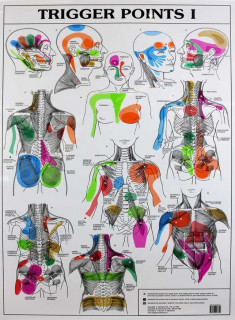
Muscle knots are those tender lumps in your muscles therapists find. They are arguably the biggest cause of musculoskeletal pain such as back, neck and shoulder pain, yet are so often either not diagnosed or poorly treated so they progress to become chronic debilitating pain syndromes, including fibromyalgia. To help avoid that, in this article we’ll show:
Muscle knots are tender lumps with your muscles that shoot pain when pressed upon. They are parts of your muscle that have gone into spasm or “cramped” forming the lump. As we’ll discuss in the section on what muscle knots do, these spasms “lock on" and continue to grow causing a host of adverse effects including often eventual pain.
The technical name
There are no actual knots in the muscles. They just feel like knots. The technical name for muscle knots is (myofascial) trigger points.
Muscle knots can cause muscular pain, plus as we will see later will affect the way your muscles works. Symptoms may be deep muscular pain, reduced performance and easy fatigue. Symptoms will often increase with activity.
Muscle knots cause muscles to abnormally tighten, reducing flexibility. It is important to note that this tightness can make muscles easy to tear, or cause problems where they attach (such as tennis elbow ).
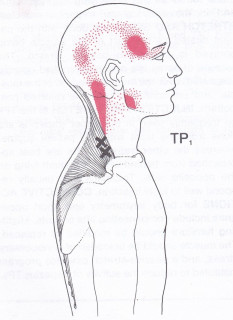
Muscle knots often refer pain away from the actual problem. This example shows the common problem of muscle knots in the upper trapezius muscles causing headaches.
Muscle knots can cause chronic pain, disturbances to sleep, plus as mentioned above cause muscles to easily fatigue. These can contribute to a variety of issues ranging from being tired and run down through to psychological and emotional problems.
A trained therapist will find muscle knots in a matter of seconds, however they do not show up on any laboratory tests or medical imaging. Diagnosis is by examining the muscles and finding:
There are a variety of possible causes of muscle knots including blood chemistry issues and emotional stress, however, these are the big ones.
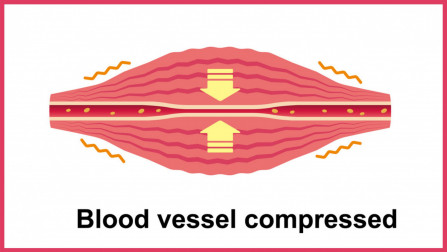
We’ll see later that a big part of muscle knots is a lack of nutrients and a build up of waste products due to reduced blood flow. The main causes of reduced blood flow are:
Examples include repeated use of forearm muscles by some trades people or production line workers.
Includes repeated strains and injuries due to sport or manual labour.
If you have musculoskeletal pain such as back neck or shoulder pain studies show that you are almost guaranteed to have muscle knots.
In an investigation of workers with pain in their neck and shoulder region the workers were checked for muscle knots in their neck, shoulder and arm muscles (1). The results were:
But what if you have no pain? An investigation of pain free adults found that nearly 90% had muscle knots in their shoulder muscles alone (2).
We’ve seen that muscle knots are a tender lump within the muscle that keeps growing over time. Scientists found that what they are is actually a combination of muscle spasm, muscle tightness and a build up of wastes (3–8). As shown below these feed on each other creating what is known as a positive feedback loop.
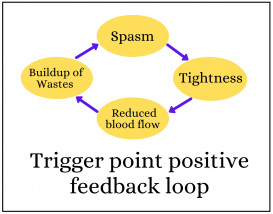
Now you know what’s happening inside the muscle lets look at the problems this causes.
The most obvious symptom of a muscle knot is pain. Scientists have made charts like the one at the start of this article showing common trigger points (the technical name for muscle knots) and where they refer pain to.
Long before muscle knots start shooting pain spontaneously they still cause pain when pressed upon and cause a host of other problems. Lets look at these.
Muscles containing muscle knots suffer from restricted blood flow and are already partially fatigued because of the ongoing spasm. Therefore you may suffer from:
Muscles with muscle knots are constantly tight, and because part is trying to contract all the time they will resist stretching. Because of this they are:
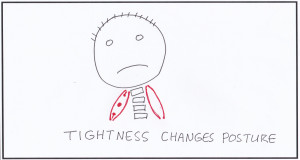
Normal posture is maintained by the tension of the muscles. An abnormally tight muscle with a trigger point will alter this balance, causing postural changes.
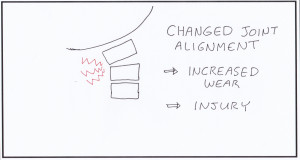
We’ve see how abnormally tight muscles due to trigger points can alter your posture. The consequence of that is that joints no longer sit in their normal neutral position. This creates uneven pressure on the joint surfaces and can result in injury or long term degeneration (abnormal wear).
Despite practically everyone having them and tmuscle knots being arguably the biggest cause of most common musculoskeletal pain syndromes they do not show up in laboratory tests or medical imaging. Further, drug companies make no money from treating them. Because of this trigger (the technical name) are rarely mentioned in medical journals and doctors are instead advised to prescribe symptom relieving drugs. As examples, the following articles discuss conditions where trigger points are a huge cause but rarely mentioned in medical journals.
If muscle knots are diagnosed they are often poorly treated. The key issue is that therapies are used to (temporarily) stop muscle knots shooting pain, but not to eliminate them (15,16). They call this “deactivating” the muscle knot. This applies whether it’s a course of needles or laser, or a release technique you’ve seen on youtube. We discuss in our article Why do trigger points keep coming back .
I hope you can see the problem with this. The muscle knots are still there. They still cause all the extra problems discussed above, and of course will start hurting again as soon as they are re-aggravated. Later we’ll show you a much better way of doing things.
Further discussion of medical and professional muscle knot therapies
As we have seen neither failing to diagnose trigger points and masking them with symptom relieving drugs, nor typical muscle knot therapies that just deactivate trigger points actually get rid of the muscle knots. Therefore too often muscle knots are allowed to continue to cause pain for years and often decades.
As discussed in our article on fibromyalgia , over time the continued bombarding with pain sensitises your nervous system so it becomes like a pain amplifier. When this happens normal sensations become painful and painful stimuli become much more severe. This is the basis of fibromyalgia, but can also be a major factor in a lot of other chronic (long term) pain syndromes.
As mentioned above, the typical goal of muscle knot therapy is to merely deactivate the muscle knots, not get rid of it. To the uninformed the pain goes away and the problem is fixed, but of course it is still there. Please allow us to share with you an example that shows how futile a lot of courses of trigger point therapy actually are, but do show us how trigger points can actually be eliminated.
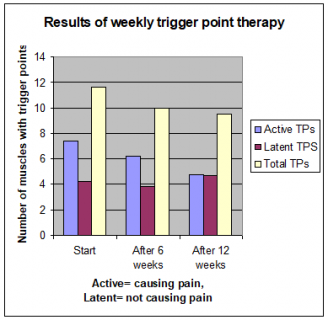
In this trial the world’s top trigger point (the technical name for muscle knots) scientists used 12 very extensive trigger point therapy sessions to test whether trigger points caused shoulder pain (17). This produced excellent symptom relief, but as you can see by this chart after all that treatment about 2/3 of trigger points were still there.
If 12 extensive therapy sessions from the world’s best trigger point scientists could only eliminate 2/3 of trigger points neither the trigger point release you learned of YouTube or a course of half a dozen needles, laser or massage therapy sessions are going to make much of an impact.
The 12 sessions did relieve the pain and eliminate 1/3 of trigger points, so if effective treatment is continued it is likely the trigger points will continue to diminish and maybe go altogether. Because of this the basis of our effective therapy is to have an effective home therapy that you can easily and inexpensively keep repeating, to not only relieve pain but to continue working on the trigger points.
We have a separate article How to treat trigger points at home that gives the complete strategy plus multiple effective self treatment options. So here we will just give a summary of the important points, plus the best home trigger point therapy option.
You may be able to do a lot of therapy yourself, but to help you get the best possible results and to stay safe we recommend that you get some professional advice.
You may need to at least temporarily avoid activities that aggravate the condition
We’ve seen that 12 sessions from the world’s best only partially remedied the problem, so:
Luckily we’ve got the ideal solution: using a vibration massager. We have a lot more information about this in our article How to treat trigger points at home , but proper vibration massagers not a massage gun or percussion massager are:
There are some good units on the market, but a lot that are not that effective. Please see our article How to choose a massager . Be especially aware that most massage guns are based on percussion massage rather than vibration. This is a gimmick that makes them a lot less effective and potentially dangerous .
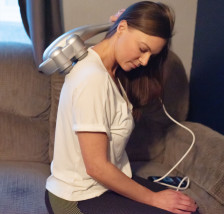
We make two hand held massagers that are easy to use and give excellent therapeutic vibrations. These are our General Purpose Massager and our Ultimate Quad Head Massager . They are very effective on trigger points. We have had the General Purpose Massager for about a decade and it is widely used by professionals across Australia, New Zealand, the UK and Europe. Our newer machine the quad head has the advantage of being able to treat a larger area at one, plus can easily be used as a “chair massager” or “cushion massager.
DrGraeme massagers were originally built by Dr Graeme for use in his clinic, and to prescribe to his patients for additional self use at home. Now these are used by colleagues and other professionals for similar purposes. If you are a professional and wish to know more about this therapy, or possibly get a sample massager to trial please check out our practitioner page .
The medics have a wide selection of medications they use to relieve the symptoms of trigger points. Of course they do nothing to eliminate the trigger points, and all the non-pain effects will still be there.
Our article What is the best treatment for trigger points discusses the research backing for the professional therapies below. As mentioned above though all made the goal of pain relief rather than elimination. In the trials they often did 5-10 therapy sessions, which is a large expense and inconvenience for what amounts to temporary pain relief.
We are continually adding more information on research and uses. Subscribe below to have us email them to you "hot off the press".

Several years ago Dr Graeme, a Chiropractor practicing in Victoria, Australia was looking for a serious hand held massager his patients could use at home to get the extra quality massage they needed. The ones he found in the shops and on-line for home use looked nice but were not serious, and... read more
As practitioners we are continually dealing with dysfunctional musculoskeletal systems. Typically dysfunction develops and is perpetuated... Read Article
A gimmick is something that is not of real value used to attract attention, usually to get you to buy something. Massager guns certainly... Read Article
Although often described as “misaligned vertebrae” or “bones out of place” most issues that cause back pain actually involve abnormal... Read Article
It has been long understood that vibration massage can accelerate healing by increasing blood flow and tissue oxygenation. Until... Read Article
In this article we will discuss the health and wellness benefits of regular or wellness massages that have been scientifically... Read Article
Do not refresh or leave this page until loading complete.